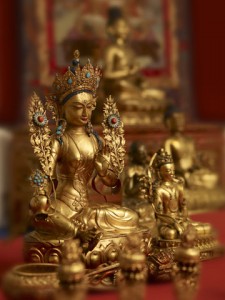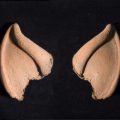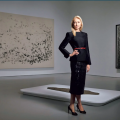From the Secretary: In the Realm of the Buddha
Shortly after the Sept. 11 attacks in 2001, 20 Tibetan Buddhist monks came to the Smithsonian to offer their prayers to help America heal. For days, they worked to create an intricate sand mandala by pouring sand, a few grains at a time, onto a large wooden platform in the Arthur M. Sackler Gallery. Smithsonian visitors watched as the monks’ painstaking effort created an astonishingly beautiful seven-foot-square sand painting that was then ritualistically destroyed to symbolize the Buddhist belief in the transitory nature of material life.
In March, Smithsonian staff and visitors once again had the extraordinary opportunity to experience the sacred Buddhist tradition of mandala creation during opening week of the Freer and Sackler Galleries’ celebration of traditional Tibetan art, “In the Realm of the Buddha.” Buddhist monk and mandala master Venerable Ngawang Chojor created a Tibetan sand mandala in the Sackler pavilion March 13–21. As the master explained to me when I visited with him during a preview tour of the exhibitions, the mandala is a two-dimensional representation of a three-dimensional palace that exists in the mind of the artist; it is considered a place where Buddhist deities reside.

Tara, Central Tibet, second half of the 17th century. Pictured in the Tibetan Shrine from the Alice S. Kendall Collection. (Photo by Neil Greentree)
The intricate process of creating a mandala, which requires great patience and focus, serves as an aid to Buddhist meditation. Upon completion, the mandala was consecrated, then swept up and dispersed, emphasizing the impermanence of existence.
Over the course of the next four months (March 13 to July 18), “In the Realm of the Buddha” will offer exhibitions and educational programs to help the public better understand Tibetan art, a complex and highly symbolic form of expression that serves as a window into the broader philosophy, practice and ritual of one of the world’s great religions.
The opening weekend celebration featured the world premiere of the feature film “Buddha” narrated by Richard Gere, which is scheduled to be shown on PBS the evening of April 12. In upcoming Sackler Gallery programs, monks and members of the Tibetan community will talk about the family shrines displayed in the Sackler’s education space.
Children and families will have a chance to try first-hand the Tibetan art of wood-block printing and thangka (scroll) painting. Two exhibitions at the Sackler—“Lama, Patron, Artist: The Great Situ Panchen” and “The Tibetan Shrine from the Alice S. Kandell Collection”— are a highlight of the four-month celebration (March 13 – July 18). Each of these exhibitions is laden with meaning and nuance and each represents a rare glimpse into Tibetan art, life and traditions that I found fascinating.
“Lama, Patron, Artist: The Great Situ Panchen” presents new scholarship and recently discovered paintings that shed light on the remarkable Situ Panchen (1700-1774)—artist, teacher and founder of the Palpung monastery. I was interested to learn that he was a recognized intellectual leader and exchanged letters and ideas on art with the emperor of China. Chinese influences on Situ Panchen’s art can be seen in works such as a stunning bronze sculpture of the White Tara, goddess of longevity, who I understand was Situ Panchen’s favorite deity.
The Situ Panchen exhibition was organized by one of the Smithsonian’s affiliates, the Rubin Museum of Art in New York, which opened in 2004 dedicated to the collection, display and preservation of the art of the Himalayas and surrounding areas.

Chakrasamvara, Padmasambhava, Pema Jungne Kham Province, Eastern Tibet; late 18th–early 19th century. (Image courtesy Rubin Museum of Art)
The Sackler Gallery is hosting the Situ Panchen exhibition as part of its “Asia in America” program, which showcases important American institutional Asian art collections.
In the second exhibition, “The Tibetan Shrine from the Alice S. Kandell Collection,” an extraordinary Tibetan Buddhist shrine room is on public display for the first time. The shrine room—considered by practicing Buddhists as a sacred space—contains a highly ordered collection of hundreds of works of Buddhist art created between the 12th and 19th centuries, including bronze sculptures, thangkas and ritual objects. As I wandered through the shrine room, the collection in its entirety surrounded and enveloped me, making a strong impression with its visual impact. The room not only reveals how Tibetan Buddhist art was originally intended to be viewed, but it also offers visitors a profound and spiritual experience.
“In the Realm of the Buddha” is an important example of how we can rise to meet the grand challenges presented in our strategic plan, including the goal of “Valuing World Cultures.” With a presence in some 100 countries, along with collections that encompass the globe, the Smithsonian has a special responsibility to explore the diversity of human experience, highlighting the creativity, traditions and cultural insights that help us interpret our world.
This time-lapse video shows how the sand mandala was created.
Posted: 1 April 2010
- Categories:








